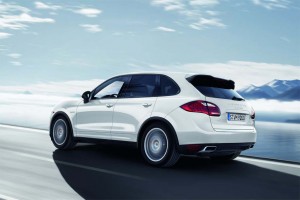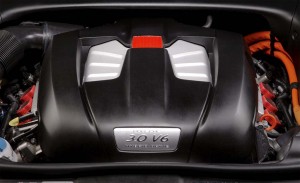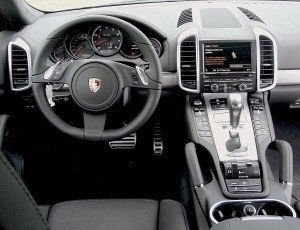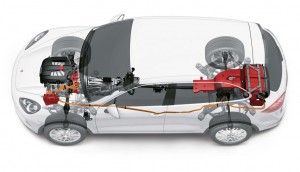Let’s face it, Porsches have always looked good in ticket-me-red. But with the launch of the German maker’s first gas-electric model, the 2011 Cayenne Hybrid, Porsche could look better in green.
The Porsche Cayenne, the venerable German company’s first SUV, generated huge amounts of cash, became the company’s best-selling product, and enabled the company to expand safely into new territory with more 911 and Boxster variants, the Cayman sports car and the Panamera luxury sedan. The Cayenne is the company’s best-selling model ever, with 282,000 sold so far.
For model year 2011, Porsche has made significant changes to the big sport-utility vehicle, and also expanded the still-new Panamera product line to include a V6-powered version for those customers who don’t want or need a V8 or a turbocharged V8 to make them happy.
For all models, the 2011 Cayenne has an all-new front, side and rear appearance, and, through careful application of engineering, is an astounding 400 pounds lighter (more than that was actually taken out, but was offset by the additional equipment built into the 2011 models), even though it is better equipped and two inches longer overall.
New technology added to the Cayenne portfolio includes a new lightweight all-wheel-drive system with a multi-plate clutch to manage torque between the front and rear axles.
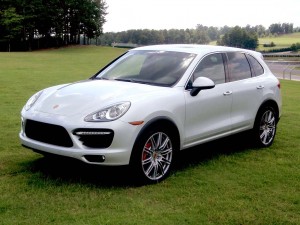
Like the rest of the 2011 Porsche Cayenne line-up, the Hybrid gets a number of visual updates for '11.
Another new technology is Porsche Torque Vectoring Plus (PTVP), which automatically brakes the inside rear wheel in turns and racetrack corners in order to make the Cayenne turn in like a race car. It’s a $1480 option, and worth every penny.
We drove Cayenne S models first without and then with the system at Barber Motorsports Park, home of the Porsche Sport Driving School in Alabama, and the difference in cornering performance was dramatic.
The happy Cayenne family, which has until now included the V6 Cayenne, the V8 Cayenne S, and the turbocharged V8 Cayenne Turbo, now welcome the addition of the Cayenne S Hybrid.
The S Hybrid, some three and a half years in development, uses a supercharged version of the VW/Audi 3.0-liter V6 engine, which itself generates 333 horsepower — with an additional 47-horspower for its electric motor bringing the total of 380 horsepower and 428 foot-pounds of torque.
Greener, perhaps, but quick, too, as that’s plenty close to the output of the 4.8-liter V8 in the regular Cayenne S. Porsche says the 2011 Cayenne Hybrid will accelerate from 0 to 6 mph in 6.1 seconds, and reach 150 mph.
(Porsche is making a surprisingly serious commitment to hybrid technology and is expected to have a plug-in model ready for production in 2013. Click Here for more.)
Porsche’s very first hybrid system has an E-mode switch, which can operate the vehicle entirely on electricity in slow-moving commuting situations up to 37 mph (we actually saw 41 mph going downhill).
In “sailing mode,” which can operate up to 97 mph, both the engine and electric motor shut off completely, and the vehicle also shuts down every time it comes to a stop, automatically starting again, almost imperceptibly, when the driver’s foot lifts off the brake pedal.
Regenerative braking is used to recharge the battery. The system, developed with battery partner Sanyo, keeps the charge between 45 and 75 percent of the battery pack’s potential capacity – a strategy most makers are using to extend battery life as much as possible.
The Cayenne S Hybrid is a full parallel hybrid system, meaning that it can operate on electricity, gasoline, or both, and uses the standard 8-speed Tiptronic S automatic transmission, rather than a unique continuously variable transmission system like the one on Toyota, Lexus and most other current hybrid systems.
The electric motor and the decoupler or clutch mechanism are placed ahead of the transmission. The system incorporates hill descent control as well as a hill-holder.
Porsche estimates that the 2011 Cayenne S hybrid will achieve 21 miles per gallon city, a 30 percent improvement compared to the V8-powered S version, and 25 miles per gallon highway. The price for this mileage and emissions performance is $67,700, a nice, round $4000 more than the Cayenne S V8. The 2011 Cayenne V6 will price at $46,700, the S at $63,700, and the new Turbo at $104,500.
(2011 Lincoln MKZ Hybrid will carry the same price as the ’11 gas model. Click Here for more.)
The Panamera luxury sedan has two new models for 2011, called Panamera and Panamera 4, both powered by a completely new direct-injection V6 engine. The 90-degree V6 engine is essentially a 4.8-liter V8 with two cylinders lopped off and a balance shaft mechanism added to smooth out the engine’s offbeat pulses. It is rated a 300 horsepower at 6200 rpm and 295 foot-pounds of torque at 3750 rpm.
Because it is based on the V8, it also carries all of the bigger engine’s technology, including variable cam timing, dry-sump lubrication with an on-demand oil pump, variable intake tuning, and automatic stop/start. The Panamera 4 version is, of course, the V6 engine coupled to all-wheel-drive, using the 7-speed PDK double-clutch transmission.
Porsche says the V6 will accelerate from 0-60 mph in as little as 5.8 seconds, while offering 18 mpg city and 27 mpg fuel economy in the rear-drive version, 18/26 in the all-wheel-drive version.
On the roads outside Birmingham, Alabama, and on the track at Barber Motorsports Park, the V6 Panamera proved to be responsive and entertaining to drive, lighter in weight but lower in power and far lower in price than the $89,800 V8 car or the $132,600 AWD Turbo version. Prices start at $74,400 for the basic Panamera V6, $78,900 for the Panamera 4.
(Porsche is making a surprisingly serious commitment to hybrid technology and is expected to have a plug-in model ready for production in 2013. Click Here for more.)

